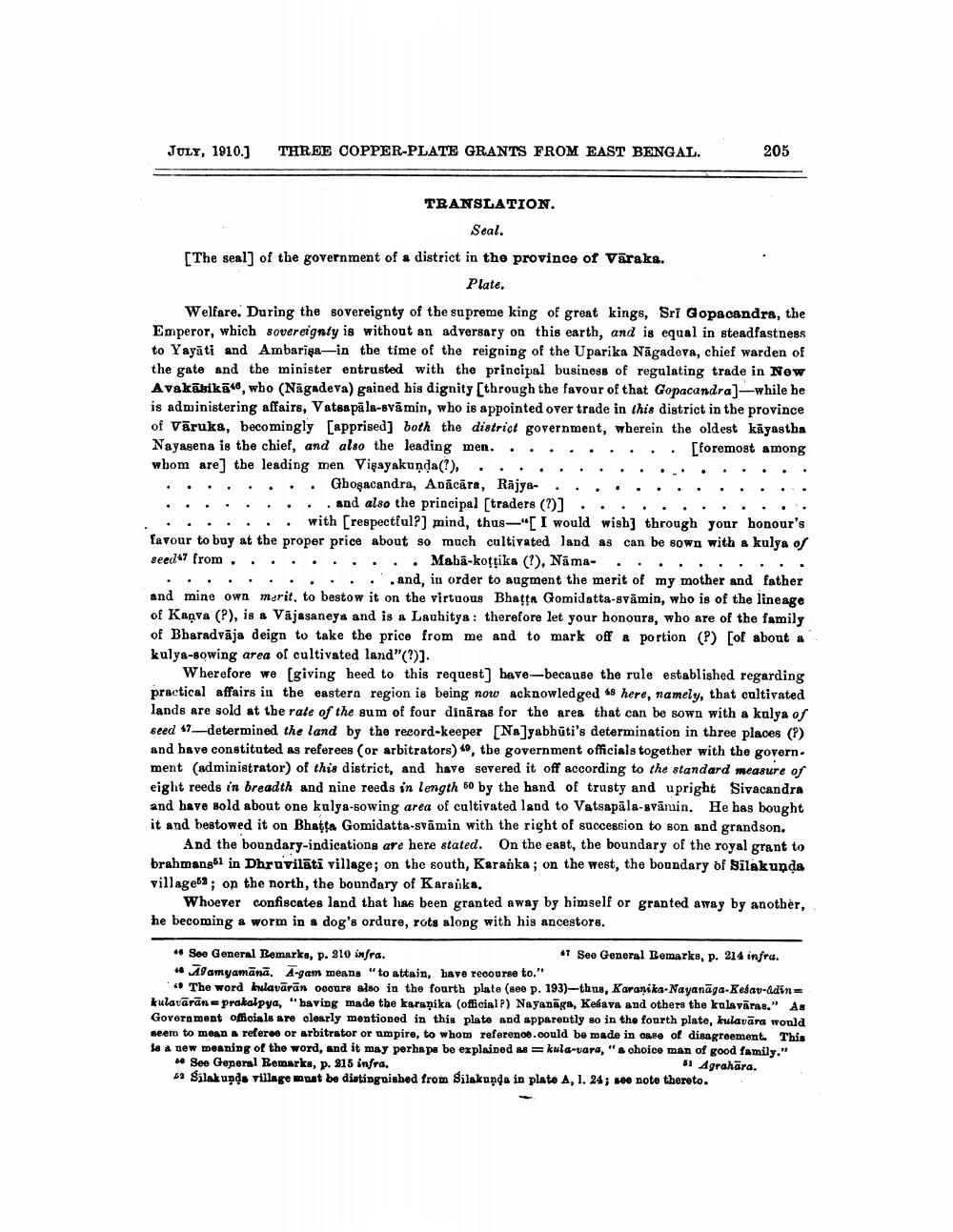________________
JULY, 1910.]
THREE COPPER-PLATE GRANTS FROM EAST BENGAL
205
TRANSLATION.
Seal. [The seal) of the government of a district in the province of Vāraka.
Plate. Welfare. During the sovereignty of the supreme king of great kings, Sri Gopacandra, the Emperor, which sovereignty is without an adversary on this earth, and is equal in steadfastness to Yayāti and Ambarişa-in the time of the reigning of the Uparika Nāgadeva, chief warden of the gate and the minister entrusted with the principal business of regulating trade in New Avakābikā e, who (Nāgadeva) gained his dignity [through the favour of that Gopacandra]—while he is administering affairs, Vatsapā la-Bvāmin, who is appointed over trade in this district in the province of Vāruka, becomingly [apprised] both the district government, wherein the oldest käyastha Nayasena is the chief, and also the leading men.......... [foremost among whom are] the leading men Virayakunda(?), . .. . .. . . . ... . .. . . .
. . . . . . . . Gboşacandra, Adācāra, Rajya- . . . . . . . . . . . . . . . . . . . . . . and also the principal (traders (?)] . . . . . . . . . . . .
......with [respectful?) mind, thus-"[ I would wish] through your honour's favour to buy at the proper price about so much cultivated land as can be sown with a kulya of seed"7 from .......... Maba-kotţika (!), Nama- . . .. . .. .. .
. ...........and, in order to augment the merit of my mother and father and mine own marit, to bestow it on the virtuous Bhatta Gomidatta-svāmin, who is of the lineage of Kanva (?), is a Vājasaneya and is a Lauhitya: therefore let your honours, who are of the family of Bharadvāja deign to take the price from me and to mark off a portion (?) [of about a kulya-Bowing area of cultivated land" (?)].
Wherefore we (giving heed to this request] have-because the rule established regarding practical affairs in the eastern region is being now acknowledged 48 here, namely, that cultivated lands are sold at the rate of the sum of four dināras for the area that can be sown with a kulya of seed 17-determined the land by the record-keeper [Na]yabhūti's determination in three places (R) and have constituted as referees (or arbitrators), the government officials together with the govern. ment administrator) of this district, and have severed it off according to the standard measure of eight reeds in breadth and nine reeds in length 50 by the hand of trusty and upright Sivacandra and have sold about one kalya-sowing area of cultivated lend to Vatsapāla-svānin. He has bought it and bestowed it on Bhatta Gomidatta-svāmin with the right of succession to son and grandson.
And the boundary-indications are here stated. On the east, the boundary of the royal grant to brahmang51 in Dhruvilāti village; on the south, Karanka; on the west, the boundary of Silakunda village6; on the north, the boundary of Karaika.
Whoever confiscates land that has been granted away by himself or granted away by another, he becoming a worm in a dog's ordure, rots along with his ancestors.
*See General Remarks, p. 210 infra.
11 See General Lemarks, p. 214 infra. * 9 amyamānā. A-gam means "to attain, have recourse to." *** The word hulavārān ooours also in the fourth plate (see p. 193)--thus, Karanika-Nayanaga-Kesav-Adin= kularārān= prakalpya, "having made the karanika (official) Nayanāga, Kesava and others the kulavārae." As Govora ment officials are clearly mentioned in this plato and apparently so in the fourth plate, kulavāra wonld seem to mean referee or arbitrator or umpire, to whom referenob.could be made in one of disagreement. This to a new meaning of the word, and it may perhaps be explained as = kula-vara, "a choice man of good family." - See General Remarks, p. 815 infra.
Silakunde village must be distinguished from Silakuņda in plato A, 1. 24; se note thereto.
1 Agrahāra.




